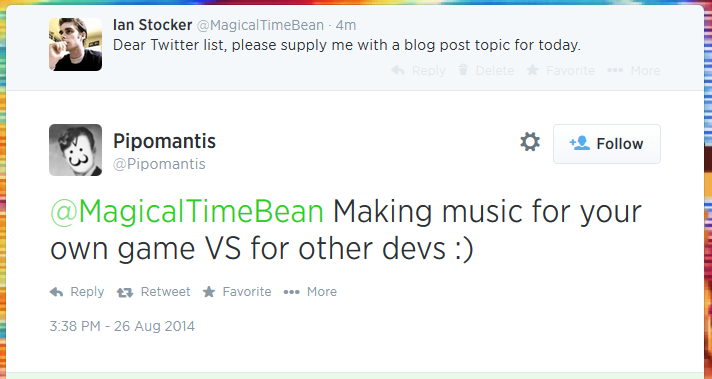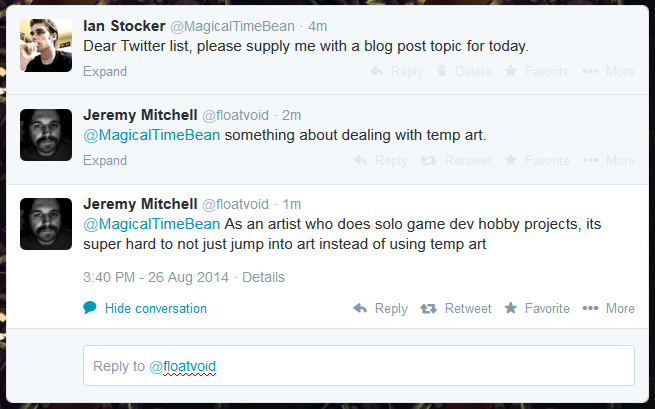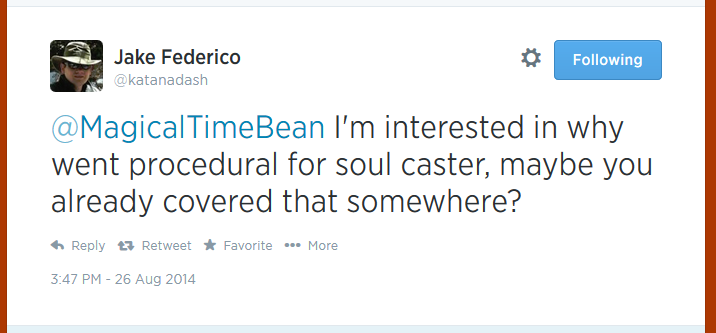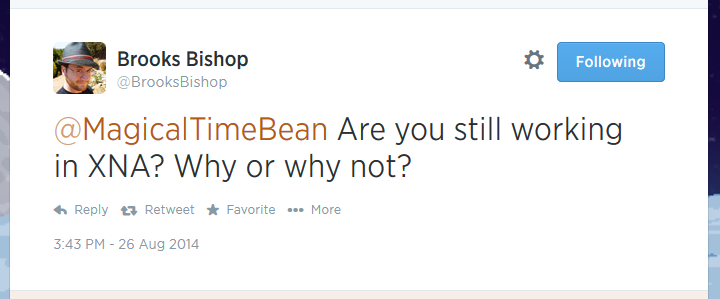With today’s work on Soulcaster mostly being behind-the-scenes stuff involving the new slotting equipment/inventory system, I figured I didn’t have much to say on that topic today. I decided to poll my Twitter list for topic ideas, and got several I could answer lightning-round style. Here goes.

On my own games, I get to pick whatever style I want, and have final approval. This does not necessarily make things any easier. Lack of constraints can be paralyzing for me, so I usually set up some artificial constraints before starting the score. On all four of my games so far, I’ve gone for something of a 90’s era redbook audio vibe. Soulcaster used Lagoon (SNES) as its main inspiration, Soulcaster II used Labyrinth (the movie), Escape Goat used Castlevania: Curse of Darkness, and Escape Goat 2 drew a bit from Bayonetta. All of the instrument sets were restricted to software versions of hardware that was available in the 80’s and 90’s.
 Some devs really hate using temp art or audio. Maybe this is because it has a tendency to install itself into the game’s theme during its formative weeks, and corrupt whatever hope of uniqueness the game could have had if only it found its own voice from the start. I actually don’t mind temp assets very much, and my games tend to have placeholder art for months on end. I just have to be willing to part with the original style when a new theme comes up. Escape Goat started as a generic platform game with stacking blocks (the protagonist was ripped from Soulcaster), and the whole goat thing came a few months into development. Soulcaster’s early prototypes used art lifted from Gauntlet, Final Fantasy, and Zelda. I just like to be able to experiment with stuff without committing lots of energy to artwork–it’s always tragic when you have to throw away hours of work because the feature didn’t pan out how you were hoping.
Some devs really hate using temp art or audio. Maybe this is because it has a tendency to install itself into the game’s theme during its formative weeks, and corrupt whatever hope of uniqueness the game could have had if only it found its own voice from the start. I actually don’t mind temp assets very much, and my games tend to have placeholder art for months on end. I just have to be willing to part with the original style when a new theme comes up. Escape Goat started as a generic platform game with stacking blocks (the protagonist was ripped from Soulcaster), and the whole goat thing came a few months into development. Soulcaster’s early prototypes used art lifted from Gauntlet, Final Fantasy, and Zelda. I just like to be able to experiment with stuff without committing lots of energy to artwork–it’s always tragic when you have to throw away hours of work because the feature didn’t pan out how you were hoping.
That’s the real danger of avoiding temp art–you become unwilling to part with your high quality art, even when the design calls for it, and something’s sticking in your game that shouldn’t be there.
Soulcaster 3 is still XNA! The main reason for this is that I have lots of XNA code I can draw from, and I don’t want to write a new engine from scratch. I know everyone’s on the Unity train these days, and XNA has been put out to pasture by Microsoft, but I still love using it. Bear in mind that I no longer use vanilla XNA, but have a mutant steroid-infused version courtesy of @antumbral.
 I haven’t really gone into detail on this yet. I could talk for much longer on this subject, but for now I’ll just say that I think this is a really hot genre. The two games I have put the most time into this year are Banished and Dungeon Crawl Stone Soup, both procedural.
I haven’t really gone into detail on this yet. I could talk for much longer on this subject, but for now I’ll just say that I think this is a really hot genre. The two games I have put the most time into this year are Banished and Dungeon Crawl Stone Soup, both procedural.
The real emotion that keeps me coming back to them is this feeling of gaining domain knowledge of the game’s inner workings, and using that knowledge to beat the game, at its own game. After every death, I can look at ways I could have done things differently to have survived. Realtime rogue hybrids have been really big lately on the PC indie scene, and I plan to bring my favorite elements of Crawl and Banished to the experience. I’m actually a bit of a procedural skeptic, since I focus so much on the craftsmanship of levels–but I think some genres can really lend themselves to it. With a bit more RPG stuff, the tactical dungeon crawling of Soulcaster will make a really fantastic rogue hybrid experience.
